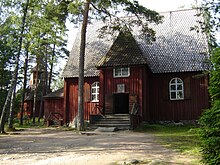Seurasaari

Seurasaari [ ˈsɛu̯rɑsɑːri ] ( Swedish. Fölisön ) is an island in the Finnish capital Helsinki . It is a popular local recreation area and the location of an open-air museum that presents Finnish building and living culture.
Location and use
The approximately 0.46 km² large island of Seurasaari is located in the Seurasaarenselkä bay a few kilometers northwest of the city center across from the Hietaniemi city beach. It belongs to the Meilahti district and is connected to the mainland by a 200-meter-long wooden pedestrian bridge. Bus 24 connects the city center with the opposite end of the bridge, and in summer there is also a boat connection from Kauppatori Square to Seurasaari. The uninhabited island is characterized by granite round humps and forests. In addition to various water birds, the animal world includes tame squirrels .
Thanks to its park landscape and two beaches, Seurasaari is a popular local recreation area for the people of Helsinki. Various festivals are held on the island every year, of which the midsummer festival (Juhannus) in particular attracts numerous visitors.
history
Until the end of the 19th century, the island served as the grazing land for Meilahti Manor. The Swedish name Fölisön ("Foal Island") also suggests this. In the 1880s, the island became a popular destination for Helsinki city residents. This gave the island the Finnish name Seurasaari ("society island "). In 1889 the city of Helsinki leased Seurasaari and gave the island to the Helsinki non-profit serving company (Helsingin Anniskeluyhtiö) for use. The serving company developed Seurasaari into a local recreation area with a network of paths, a boat landing stage, a restaurant and dance pavilions. In 1891–92 the bridge was built from the trunks of trees felled by a strong autumn storm. The Seurasaari open-air museum was founded in 1909 when, at the instigation of the painter Akseli Gallen-Kallela and the architect Yrjö Blomstedt, the Niemelä small leasehold, threatened by demolition, was relocated from Konginkangas in Central Finland to Seurasaari. Under the first curator, Axel Olai Henkel , Seurasaari was expanded into an open-air museum based on the model of Skansen in the Swedish capital Stockholm . The Seurasaari Foundation (Seurasaarisäätiö) has supported the work of the museum since 1956 .
open air museum
The Seurasaari Open Air Museum has 87 historical buildings from the 17th to 20th centuries, which represent the building traditions in different parts of Finland. With the small farmyard Niemelä from Konginkangas and the farm Antti from Säkylä in western Finland, there are two complete farms on the island. The wooden church of Karuna was built in 1685–86 and moved to Seurasaari in 1912 after a new church was completed. Other noteworthy buildings are the Kahiluoto Manor from Taivassalo in southwestern Finland, the Rectory from Iisalmi , the Kurssi farmhouses from Kuortane , Ivars from Närpes , Selkämä from Pieksämäki , Halla from Hyrynsalmi and the Pertinotsa house from Suojärvi , which is an example of the Karelian building tradition. The area of the open-air museum is freely accessible, but an entrance ticket must be purchased to enter the building.
See also
Web links
Coordinates: 60 ° 10 ′ 52 ″ N , 24 ° 53 ′ 5 ″ E




